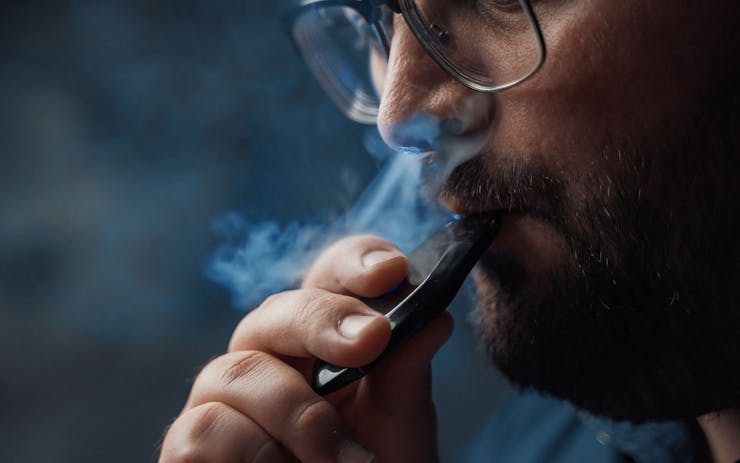This article originally ran in the Philadelphia Inquirer and is reprinted with permission.
Vaping-related illnesses have captured the attention of public officials and news media alike, and the evidence is alarming. According to the Centers for Disease Control and Prevention as of last Thursday, over 1,000 cases of lung injury associated with vaping products have been reported in the last few months, with most patients reporting that they used THC-containing products.
Many in Massachusetts who were using vape products are now shifting back to tobacco—or worse, using tobacco for the first time.
Many cases are gruesome; one Mayo Clinic pathologist likened the injuries to those seen in people exposed to poisons like mustard gas.
Though documented injuries and deaths have been climbing, the cause is not clear because the cases to date have not linked to a single product or substance. Though the CDC has cautioned those purchasing vaping products to avoid getting them from informal sources (or “off the street”), it is also possible that legal, regulated products are partly to blame. Simply put, we need more evidence.
Pressure on politicians to do something
This lack of evidence, combined with a sense of urgency and helplessness among policymakers, create a recipe for a drug panic, a widespread exaggerated fear that can lead to irrational and counterproductive interventions. Given that more patients, mostly young people, are developing vaping-related illnesses at an alarming rate, there is strong pressure and political will to do something—anything. Unfortunately, despite the best intentions, hasty decisions based on panic lead to unintended consequences.
Our home state, Massachusetts, produced the nation’s most extreme vaping response on Sept. 24 when Gov. Charlie Baker passed a four-month emergency ban on the sales of all regulated vaping products, including products containing nicotine, products containing THC, and all vape products used by the 67,000 medical cannabis patients across the state.
A temporary halt; long-term problems
Some might believe that a temporary ban on sales is an effective tool for temporarily stopping use. Yet product safety for vaping is far more complex, particularly with the rapid expansion of popular, federally illegal products that will require an entirely new regulatory framework.
Failing to consider potential negative consequences of a ban does a disservice to people whose lives are at stake.
It’s easier, and faster, from a political perspective to ban these products. Yet the assumption that a ban will stop people from using these products is inconsistent with everything we know about prohibition.
Moreover, there is a readily available illicit market for THC vape products. Unlike in the regulated market, a product in the illicit market that turns out to be harmful doesn’t have a tracked inventory record or batch number. A tainted bootleg cartridge doesn’t have mandatory testing results on file, akin to a Safety Data Sheet for pharmaceuticals.
Illicit products can’t be recalled
And unlike the required label and list of ingredients in a regulated product, the illicit product’s label is likely a sticker printed out with a fake brand name. By definition, illicit products are not subject to regulatory interventions like product recall, removal, tightening of regulations, or restriction of potentially harmful ingredients or additives.
An unintended consequence: Many of those in Massachusetts who were using now-banned vape products are shifting back to tobacco products — or worse, starting to use tobacco products for the first time.
Less than two weeks into the statewide vaping ban, convenience store owners have already noted increased sales of conventional cigarettes. Cigarette smoking is responsible for more than 1,000 deaths each day in the United States.
Sending vapers to deadly cigarettes
Any ban of vaping products has to take into account the likelihood of a market switch from e-cigarettes to conventional cigarettes, and between legal, regulated vape products for cannabis consumption and bootleg vape products containing THC.
As one helpful measure, the Massachusetts Tobacco Cessation and Prevention Program provides free support. Yet a comprehensive public health approach to the vaping challenge requires greater focus toward assisting those who want to quit e-cigarettes and medical cannabis patients who need access to other products with minimal disruption to their health.
All states with medical or legal cannabis have devoted considerable time and resources toward developing a strong regulatory structure. An outbreak of injuries is exactly the time when regulating potentially harmful products is most critical. Such regulation must be accompanied by strong public health interventions, including consumer awareness, education, prevention, and treatment.
Look at the evidence and data
To arrive at a data-driven approach to the public health challenge of vaping, our most important first step is to gather evidence and collect data while coordinating efforts to both identify the source of the problem and implement an appropriate response. The Massachusetts Department of Public Health has wisely mandated that vaping-related illnesses be reported for the next 12 months in order to gather information and investigate possible causes.
Simplicity is tempting. If drugs are bad, why not have a war on them? If vape products cause illness, why not ban them?
But failing to consider potential unintended negative consequences of such a ban, specifically if the harms may outweigh the benefits, does a disservice to the people whose lives are at stake. We’re already seeing the consequences of the ban in Massachusetts, and we encourage other states to think twice before implementing aggressive measures that lack evidence.





